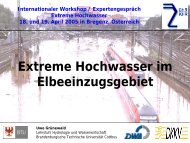ABSTRACTS 'Extreme Discharges' - CHR-KHR
ABSTRACTS 'Extreme Discharges' - CHR-KHR
ABSTRACTS 'Extreme Discharges' - CHR-KHR
Create successful ePaper yourself
Turn your PDF publications into a flip-book with our unique Google optimized e-Paper software.
For the measurement point Lobith, which is situated downstream of the Lower Rhine, the resulting peak discharges<br />
for all hydrographs can be seen in figure 3. Also here all flood waves are damped due to the dike overflow<br />
along the Upper Rhine and the Lower Rhine.<br />
In NRW and Gelderland several flood reduction measures are planned. Some of them such as lowering of groynes,<br />
lowering of the floodplains, removal of hydraulic obstacles from the riverbed or setting back of dikes will<br />
cause an enlargement of the discharge capacity between the dikes. As the study showed, these measures cause a<br />
lowering of the water level at the location of the measure and further upstream. By building retention basins<br />
water will be extracted from the river and temporarily stored. As result of this reduction of the discharge, the<br />
water level in the river at the location of the retention basin and downstream of the retention basin decreases.<br />
The investigations showed, that the planned flood reduction measures in NRW are most effective at floods equal<br />
to the flood of 1995, but have little effect under more extreme conditions. It could be shown, that these effects<br />
can be enlarged by optimizing the control levels of the planned retention basins and by improving the combination<br />
of measures (figure 4).<br />
Measures in Germany affect the water levels in the Netherlands and the other way around (figure 5).<br />
Effect planned flood reduction measures in NRW<br />
Effect planned flood reduction measures in NRW<br />
0,2<br />
0,2<br />
Difference in water level [m]<br />
0,1<br />
0<br />
-0,1<br />
-0,2<br />
-0,3<br />
-0,4<br />
1995 HW1 HW2 HW3 HW4<br />
HW5 HW6 HW7 HW8<br />
Germany<br />
NL<br />
Difference in water level [m]<br />
0,1<br />
0<br />
-0,1<br />
-0,2<br />
-0,3<br />
-0,4<br />
1995 HW1 HW2 HW3 HW4<br />
HW5 HW6 HW7 HW8<br />
Germany<br />
NL<br />
-0,5<br />
620 640 660 680 700 720 740 760 780 800 820 840 860<br />
Andernach Bonn Köln Düsseldorf Ruhror Emmerich Lobith<br />
-0,5<br />
620 640 660 680 700 720 740 760 780 800 820 840 860<br />
Andernach Bonn Köln Düsseldorf Ruhror Emmerich Lobith<br />
Figure 4. Effect of flood reduction measures<br />
planned in NRW, improved version.<br />
Figure 5. Combined effect flood reduction measures<br />
planned in NRW (improved version) and The<br />
Netherlands.<br />
4. Conclusions and outlook<br />
In the project “Effects of extreme floods along the Niederrhein (Lower Rhine)” the effects of flooding and flood<br />
reducing measures were investigated in order to get insight in the occurrence and behavioure of extreme floods<br />
along the Rhine. It was focused on the flooding pattern along the Lower Rhine and the Dutch Rhine branches, as<br />
well as the development of the discharge and the effect of the flood reduction measures in this river reach.<br />
It could be shown, that floods at the Lower Rhine can exceed the flood levels were dikes are designed for. This<br />
causes inundations along the Lower Rhine, first in the southern part, later also in the middle part. Inundation of<br />
the southern and middle part of the Lower Rhine reduces the peak discharge in the northern part of the Lower<br />
Rhine and in The Netherlands. Nevertheless in present time (situation 2002) transboundary inundations can<br />
occur. By building a flood wall, this will be prevented in future (situation 2020). The planned flood reduction<br />
measures in NRW and in the Netherlands can reduce water levels in the river. These effects can be enlarged by<br />
optimizing the control levels of the planned retention basins and by improving the combination of measures on<br />
both sides of the border.<br />
The flood design levels along the Rhine change along his course from Switzerland through Germany to The<br />
Netherlands. The study made clear, that under such circumstances the effects of flood reduction measures must<br />
be seen in combination with the effects of dike overflow upon the discharge and water level in the river. It also<br />
became evident, that the impact of dike overflow, flooding and flood reduction measures upon extreme floods is<br />
very large and should be taken into account in flood statistics. The techniques and tools, which are developed in<br />
this project will make this possible.<br />
63





